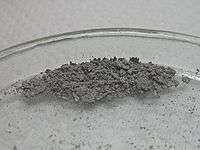Silver acetylide
| | |
 | |
| Names | |
|---|---|
| Preferred IUPAC name
Disilver acetylide | |
| Systematic IUPAC name
Disilver(1+) ethyndiide | |
| Other names
Argentous ethyndiide Argentous percarbide | |
| Identifiers | |
| 7659-31-6 | |
| 3D model (Jmol) | Interactive image |
| |
| |
| Properties | |
| C2Ag2 | |
| Molar mass | 239.76 g·mol−1 |
| Appearance | gray or white solid |
| Melting point | 120 °C (248 °F; 393 K) |
| Boiling point | decomposes |
| insoluble | |
| Hazards | |
| Main hazards | High Explosive, Toxic |
| Flash point | 77 °C (171 °F; 350 K) |
| Except where otherwise noted, data are given for materials in their standard state (at 25 °C [77 °F], 100 kPa). | |
| | |
| Infobox references | |
Silver acetylide is an inorganic chemical compound with the formula Ag2C2, a metal acetylide. The compound can be regarded as a salt of the weak acid, acetylene. The salt's anion consists of two carbon atoms linked by a triple bond. The alternate name "silver carbide" is rarely used, although the analogous calcium compound CaC2 is called calcium carbide.
Pure silver acetylide is a heat- and shock-sensitive high explosive with the unusual property that on ignition it does not evolve any gas:
- Ag
2C
2 (s) → 2 Ag (s) + 2 C (s)
A common misconception about the "silver acetylide" used in commercial explosives is that it explodes without the evolution of gaseous products and that its chemical formula is Ag
2C
2. In reality, it is a double salt with the silver salt it was produced from, usually silver nitrate.[1] The anion of the parent compound acts as the oxidizer in the decomposition reaction.
The detonation velocity of the mixture silver acetylide: silver nitrate is 3460 m/s.[2] That of pure silver acetylide is 4000 m/s.
Synthesis
Silver acetylide can be produced by passing acetylene gas through a solution of silver nitrate:[3]
- 2 AgNO
3 (aq) + C
2H
2 (g) → Ag
2C
2 (s) + 2 HNO
3 (aq)
The reaction product is a greyish to white precipitate. This is the same synthesis from Berthelot in which he first found silver acetylide in 1866.[4]
Silver acetylide can be formed on the surface of silver or high-silver alloys, e.g. in pipes used for transport of acetylene, if silver brazing was used in their joints.
Solubility
Silver acetylide is not soluble in water and is not appreciably soluble in any other solvent.
References
- ↑ "Silver Acetylide (Double Salts)". Williestop.tripod.com. Retrieved 2013-01-29.
- ↑ Sam Barros. "Acetylide Explosives Synthesis". Powerlabs.org. Retrieved 2013-01-29.
- ↑ G.-C. Guo; Q.-G. Wang; G.-D. Zhou; T. C. W. Mak (1998). "Synthesis and characterization of Ag2C2·2AgClO4·2H2O: a novel layer-type structure with the acetylide dianion functioning in a 6-η1,η1:η2,η2:η2,η2 bonding mode inside an octahedral silver cage". Chem. Commun. (3): 339–340. doi:10.1039/a708439k.
- ↑ M. P. Berthelot (1866). "Ueber eine neue Klasse zusammengesetzter metallhaltiger Radicale (A new class of combined metallic radicals)". Annalen der Chemie. 138 (2): 245–253. doi:10.1002/jlac.18661380215.